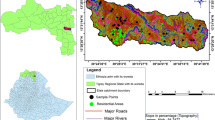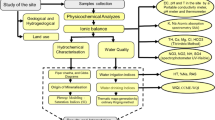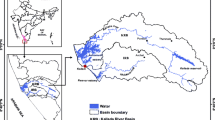Abstract
This study has compared the use of standard water quality overlay techniques with that of Getis-Ord Gi* statistical techniques for visualizing the spatial distribution of water quality parameters in an unconfined aquifer beneath the city of Lahore in Pakistan. The non-uniformly distributed groundwater sampling points were uniformly transformed to a grid of evenly distributed values to apply Getis-Ord Gi* statistics. An optimized neighborhood distance value of 700 m was determined for the Getis-Ord Gi* assessment, showing that the aquifer is regionally continuous and there are no barriers to lateral groundwater flow. This statistical approach was initially applied to individual parameters and was found to better define hotspots than that of the conventional method. Similarly, the use of Getis-Ord Gi* values improved the assessment of hotspots of water quality index (WQI) values than conventional overlay techniques.







Similar content being viewed by others
Data availability
The used data are available with WASA, Lahore, Pakistan and with authors.
References
Abbas Z, Su C, Tahira F, Mapoma HWT, Aziz SZ (2015) Quality and hydrochemistry of groundwater used for drinking in Lahore, Pakistan: analysis of source and distributed groundwater. Environ. Earth Sci, https://www.springer.com/journal/12665 74(5):4281–4294.
Alqadi KA, Kumar L, Khormi HM (2014) Mapping hotspots of underground water quality based on the variation of chemical concentration in Amman, Zarqa and Balqa regions Jordan. Environ Earth Sci https://www.springer.com/journal/12665 71(5):2309–2317.
Basharat M, & Rizvi SA (2011, April) Groundwater extraction and waste water disposal regulation Is Lahore Aquifer at stake with as usual approach In Pakistan Engg Congress; World Water Day-April 2011 112–134
Caizhi S, Xiangtao C, Xuejiao C, (2016) Evaluation and Hotspots Identification of Shallow Groundwater Contamination Risk in the Lower Reaches of the Liaohe River Plain. JRE, https://www.jorae.cn/EN/1674-764X/home.shtml 7(1), 51–60.
Chang KT (2012) Introduction to geographic information systems. McGraw-Hill Education, New York, pp 1–413
De la Torre A, Iglesias I, Carballo M, Ramírez P, Muñoz MJ (2012) An approach for mapping the vulnerability of European Union soils to antibiotic contamination. Sci Total Environ 414:672–679
Deilami K, Hayes JF, McGree J, Goonetilleke A (2017) Application of landscape epidemiology to assess potential public health risk due to poor sanitation. J Environ https://www.letpub.com/index.php?page=journalapp&view=detail&journalid=4483 192: 124–133.
Harris NL, Goldman E, Gabris C, Nordling J, Minnemeyer S, Ansari S, Potapov P (2017) Using spatial statistics to identify emerging hot spots of forest loss. Environ Res Lett 12(2):024012
Hassan GZ, Hassan FR, Akhtar S (2016) Environmental issues and concerns of groundwater in lahore. Proc Pak Acad Sci B Life Environ Sci 53(3):163–178
Jang WS, Engel B, Harbor J, Theller L (2017) Aquifer vulnerability assessment for sustainable groundwater management using DRASTIC. Water 9(10):792
Javari M (2016) Geostatistical and spatial statistical modelling of precipitation variations in Iran. IJCEE https://www.hilarispublisher.com/civil-environmental-engineering.html 10(6): 230
Kanwal S, Gabriel HF, Mahmood K, Ali R, Haider A, Tehseen T (2015) Lahore’s groundwater depletion- a review of the aquifer susceptability to degradation and its consequences. Tech J Univ Eng Technol Taxila 20(1):26–38
Li J, Heap AD (2014) Spatial interpolation methods applied in the environmental sciences: a review. Environ Model Softw 53:173–189
Li Y, Zhang L, Yan J, Wang P, Hu N, Cheng W, Fu B (2017) Mapping the hotspots and coldspots of ecosystem services in conservation priority setting. J Geogr Sci 27(6):681–696
Mahmood K, Batool, Rida (2019) Geo-statistics for Understanding Groundwater Conditions and Lateral Movement of Contaminants. Prceedings of 11th young water professional. 11th Eastern European Young Water Professionals Conference, October 1–5, 2019, Prague, Czech Republic.
Mahmood K, Ali SR, Haider A, Tehseen T, Kanwal S (2014) Selection of the optimal interpolation method for groundwater observations in Lahore, Pakistan. Pak JSIR Phys Sci 57(3):154–167
Mahmood K, Ul-Haq Z, Batool SA, RanaAD, Tariq S (2016) Application of temporal GIS to track areas of significant concern regarding groundwater contamination. Environ Earth Sci https://www.springer.com/journal/12665 75(1): 33.
Miller HJ (2004) Tobler’s first law and spatial analysis. Ann Assoc Am Geogr 94(2):284–289
Mitchell SE (2011) Using GIS to explore the relationship between socioeconomic status and demographic variables and crime in Pittsburgh. Pa Pap Res Anal 13(1):1–11
Muhammad AM, Zhonghua T(2014) Municipal Solid Waste and its Relation with Groundwater Contamination in Lahore, Pakistan. ETASR, https://www.etasr.com/index.php/ETASR7 (8):1551–1560.
Muhammad AM, Zhonghua T, Dawood AS, Eari B (2015) Evaluation of local groundwater vulnerability based on DRASTIC index method in Lahore. Pak Geofis Int 54(1):67–81
Multsch S, Pahlow M, Ellensohn J, Michalik T, Frede HG, Breuer L (2016) A hotspot analysis of water footprints and groundwater decline in the high plains aquifer region, USA. Reg Environ Change 16(8):2419–2428
Nas B, Berktay A (2010) Groundwater quality mapping in urban groundwater using GIS. Environ Monit Assess 160(4):215–227
Ord JK, Getis A (1995) Local spatial autocorrelation statistics: distributional issues and an application. Geogr Anal 27(4):286–306
Rao GS, Rao GN (2011) Study on ground water quality of greater Visakhapatnam city, Andhra Pradesh from July, 2007 to June, 2008. Asian J Chem 4(3):481–490
Author information
Authors and Affiliations
Contributions
Both the authors are genuine contributors of the research work.
Corresponding author
Ethics declarations
Conflict of interest
There is no conflict of interest.
Additional information
Publisher's Note
Springer Nature remains neutral with regard to jurisdictional claims in published maps and institutional affiliations.
Rights and permissions
About this article
Cite this article
Mahmood, K., Batool, R. Comparison of stochastic and traditional water quality indices for mapping groundwater quality zones. Environ Earth Sci 79, 405 (2020). https://doi.org/10.1007/s12665-020-09148-3
Received:
Accepted:
Published:
DOI: https://doi.org/10.1007/s12665-020-09148-3




